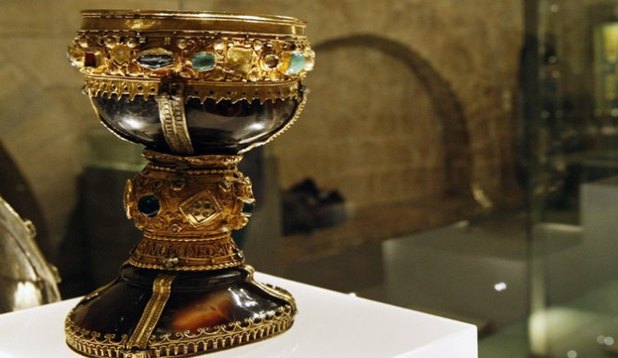The Latest Not So Holy Grail
 Two Spanish researchers claim to have found the Holy Grail. The artifact in question is located in the San Isidro Basilica in Leon, Spain. Margarita Torres and José Manuel Ortega base their assertion on two Egyptian parchments found at the University of Al-Azhar in Cairo Egypt. The parchments state that this chalice was used by Jesus at the Last Supper. Upon Christ’s death it was said to come into the possession and care of Joseph of Arimathea. According to the Egyptian parchments, the “Grail” was later taken by Muslims from the Christian community in Jerusalem to Cairo.
Two Spanish researchers claim to have found the Holy Grail. The artifact in question is located in the San Isidro Basilica in Leon, Spain. Margarita Torres and José Manuel Ortega base their assertion on two Egyptian parchments found at the University of Al-Azhar in Cairo Egypt. The parchments state that this chalice was used by Jesus at the Last Supper. Upon Christ’s death it was said to come into the possession and care of Joseph of Arimathea. According to the Egyptian parchments, the “Grail” was later taken by Muslims from the Christian community in Jerusalem to Cairo.
In later years, when Egypt was suffering a famine, they passed the chalice to an emir, named Denia, because of his help during that time. Eventually, the chalice was passed on to King Ferdinand the First, of Castile Spain. The “Grail” formally known as the goblet of the Infanta Dona Urraca, who was king Ferdinand’s daughter, has been in Spanish possession for more than 800 years.
In recent times this cup has been used by Pope Benedict during a mass at Valencia Cathedral in 2006 prior to the declaration of its current status of being the elusive “Grail” of legend. Some historians say it has been in the San Isidro Basilica since the 11th century. The cup is believed to have been made between 200 BC and 100 AD. Professor Torres has been quoted as saying “The first 400 years of the chalice’s history remains something of a mystery.” She goes on to say “The only chalice that could be considered the chalice of Christ is that which made the journey to Cairo and then from Cairo to Leon – and that is this challis.”
Every few years there is another controversy about something like the “Holy Grail” or the “Shroud of Turin” or finding the remains Noah’s Ark that proves to be less than factual. In most cases, very few people can agree on these things and the controversy holds until the latest declaration of proof on one of these various legends. I would suggest that this is just one more example of sensational reporting by an “expert” of an artifact said to possess holy properties and origins.
The quest to discover the “Holy Grail” has had a very long and convoluted history, if not sordid. The Grail legend dates back to the ancient Celts and was a key relic of their ancient pagan gods. It was later incorporated into the literature and legend of King Arthur and the Knights of the round table. The Grail also became part of the lore of the four centuries of the Crusades, and as a result became part of the legends of the Knights Templar. In these legends, the Grail is purported to have healing properties and is considered by some to be more of a talisman, a cauldron or a magic vessel. The “Grail” was purported also to be the property of the Irish goddess Boin and was linked to nature cults of harvest and abundance. In conjunction with the stories of King Arthur and the realm it was believed to be stowed away in Glastonbury, Scotland. In the era of the Crusades and the Knights Templar, the vessel was considered to have been hidden by the Knights Templar at the Clairvaux monastery in France. The “Holy Grail” was described by the poet Cretian, to be solid gold with precious stones encrusted and was more of a platter than a chalice. The current inception bears no resemblance to this description. The timing of this announcement is curious, as it is just before the celebration of both Passover for the Jews and Easter for the Christians. This cup was said to be used by Christ at the Passover feast he celebrated with the disciples, at which time he transformed the Passover wine into the celebration of his new covenant in the Eucharist, according to the Catholic Church. One thing the experts laud about the cup is that it is a “tangible relic with holy powers”. Can a relic with such a confused history and so many conflicting opinions about its whereabouts really be taken seriously?
“Then if any man shall say unto you, Lo, here is Christ, or there; believe it not.” Matt 24:23
- The Seduction - January 17, 2021
- The Science of Prophistory - January 17, 2021
- The Road To Philadelphia - January 17, 2021

